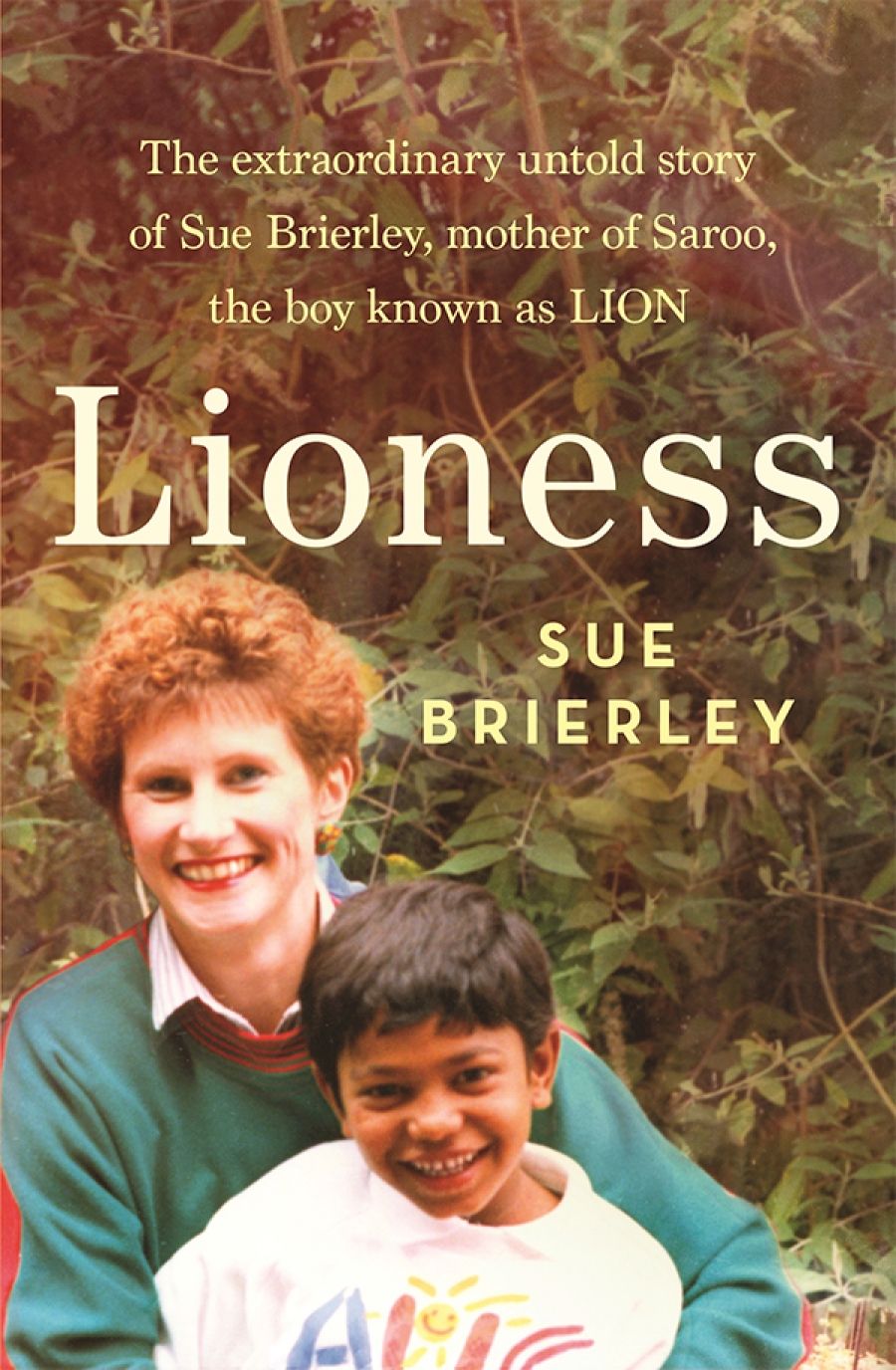
- Free Article: No
- Contents Category: Memoir
- Review Article: Yes
- Article Title: Sue and Saroo
- Article Subtitle: A memoir of motherhood
- Online Only: No
- Custom Highlight Text:
The vision was of a brown-skinned child standing by her side. She sensed it so keenly that she could even feel the child’s warmth. It was so striking she wondered about her sanity … but as time went by, she became more comfortable with her vision, accepted it as something precious, a visitation of some sort that only she knew about.’
- Grid Image (300px * 250px):

- Book 1 Title: Lioness
- Book 1 Subtitle: The extraordinary untold story of Sue Brierley, mother of Saroo, the boy known as Lion
- Book 1 Biblio: Viking, $34.99 pb, 271 pp
- Book 1 Readings Link: booktopia.kh4ffx.net/74Mjd
Lioness is Sue Brierley’s story, beginning with her birth to migrants recently arrived in Burnie. Josef and Julie Stelnicki, fleeing postwar Europe, believed that the ship they boarded would take them to Canada but ended up in Tasmania. Sue, the middle daughter, describes her early life as one of privation. Her father lurches from one moneymaking scheme to another in a home that increasingly resembles a junkyard; her mother attempts to protect herself from alcohol-fuelled violence. There is little affection and respect shown to the three girls.
A child’s growing awareness of the way they live, and her conviction that no one else lives that way, are described vividly. She pays tribute to people met in her young life who showed her what real love and attachment looked like. Sue escapes the hardships of her childhood through marriage, aged seventeen, to her soul mate, John Brierley.
With the prospect of becoming their own family and their shared belief in the environmental impact of the world’s over-population, they decide to adopt a child from overseas. After sixteen years of marriage, their adoption of Saroo goes swiftly and smoothly, with the help of Saroj Sood from the Indian Society for Sponsorship and Adoption (ISSA) – the book is dedicated to Mrs Sood. The adoption is expedited by the Brierleys’ lack of preference with respect to age or gender.
Saroo is described by Sue as a happy smiling boy on his arrival in Australia. At the age of six, he quickly settles into life with the Brierleys, in a home furnished with cultural objects, including a large map of India on his bedroom wall. They maintain contact with another family who have also adopted an Indian child. In the way of shared family memories, events in both Sue’s book and A Long Way Home are related almost word for word. In his book, Saroo describes how he consciously kept his memories of his early life alive by telling himself what he could remember as a kind of bedtime story. As a young adult, although not outwardly dissatisfied with his life, he began a search to find his first home by riding the rails virtually via Google Earth. He finds his family and his first mother. This memoir was adapted into the award-winning film Lion in 2016.
Three years after Saroo’s arrival, the Brierleys adopt another Indian boy, Mantosh: hence the author’s description of herself as ‘the mother of two other mothers’ children’. Mantosh’s transition into the family doesn’t go so well – he has spent longer in care after being given up by his mother. Sue describes the delays in the adoption process as exacerbating the abuse Mantosh suffers there; she believes this results in their second son being unable to connect with them, or to accept their love.
Sue has kept a diary throughout her life, and this clearly formed the basis of the book. Her vision of gazing at a ‘dark brown face’ is recounted from an entry made when she was twelve. Much of the text has the tone of a Christmas letter received from an acquaintance – travel details, lists of friends, houses visited – giving the reader more detail at times than we want to know. Once Saroo’s book is published, and then developed into a film, the family find themselves in the glare of publicity, which brings about a televised meeting between Sue and Fatima, who gave birth to Saroo. There is no doubting the emotional power of this reunion, which makes bearable accounts of meeting film stars and attending the Oscars.
Since her childhood vision in 1966, Sue has believed there should be minimal impediments to those wishing to offer disadvantaged children love and a home. She rails against the bureaucratic procedures and regulations in a way that can only be read in 2020 as tone deaf to both cultural awareness and the evidence of care survivors worldwide. She implies that a relationship between Mantosh and his birth mother, Asha Rani Das, would be as beneficial to them as it has been to Saroo and Fatima.
Remember the rush to adopt Romanian orphans by well-meaning, First World adoptive parents, who were challenged and in many cases defeated in their attempts to restore this damage using only their belief in the restorative power of love? A recent edition of The Atlantic features a story about one such orphan, Izidor Ruckel, now in his thirties.
The voices of Asha Rani Das and Fatima are the ones we need to hear next.


Comments powered by CComment